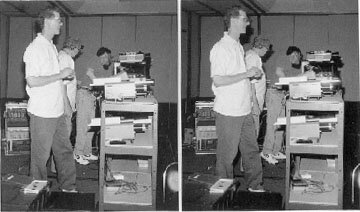
Cheering 25 NSA Years in Green Bay
by John Dennis
Among the things I didn't know about Green Bay, Wisconsin, were that it's the world's largest producer of toilet paper and that it's the home of the official U.S. National Railroad Museum. Media attention to the football team and its dedicated owner/fans in cheese hats has been overwhelming to the point its why most people know the place even exists.
What the 640+ people attending all or part or the 25th annual NSA Convention July 8-12 also learned is just what an ideal location Green Bay and its Regency Suites Hotel provide for a gathering of 3-D enthusiasts. Fortress-like on the outside, the 8 floors of suites inside face ornate, foliage enhanced balconies surrounding a large atrium that makes a valiant effort to bring a bit of New Orleans to Wisconsin. But unlike the bleak cafes or overpriced bars that lurk at the bottom of most such atriums, a fountain, planters and sidewalk cafe tables give way at one end to a space filed with tables reserved for free breakfasts every morning and two hours of complimentary drinks every evening. Word quickly spread that this meant everything from pop to wine, beer, and mixed drinks the number limited only by guests' concerns for their own health or ability to find their rooms or remember their dinner arrangements when things wound down at 7 P.M.
The combination of free breakfasts and "happy hours" were universally applauded as just the opportunity for socializing with a wide variety of other members that NSA conventions need. Instead of heading off in every direction with people you already know when projections or the Trade Fair close for the day, this arrangement mixed a large percentage of those at the convention together, nearly at random, twice a day. As NSA members occupied nearly every room in the hotel, one was virtually certain to end up among interesting stereo enthusiasts of all sorts both morning and evening. Planners will (or should) feel challenged to replicate this delightful situation to at least some degree for future conventions.
As at other atrium style hotels, it was fairly easy to spot open room hopping rooms on several floors from the opposite balcony, and even to see who was entering or leaving a particular room. But even better for in-room dealers this year was the fact that every room in the hotel is a suite with a living room and bar area in front of a separate bedroom, providing ideal table, counter and couch space for the display of wares and in most cases removing the need to spread boxes of views across a bed.
The hotel's restaurant, Smokin' Joe's, had some surprisingly inexpensive items on the menu and alternate eating places abounded in the large mall connected via skyway to the hotel. Several additional food sources were within three or four blocks, one favorite destination being the former Chicago & Northwestern Railroad Depot just across the Fox River from the hotel and now the Titletown Brewing Company microbrewery and restaurant.
Stereo Theater
The Stereo Theater and Trade Fair were in the Regency Conference Center adjacent to the hotel and reached through a ground floor doorway into the lobby. John and Dace Roll were this year's Stereo Theater Coordinators. With the precedent of smoothly run shows projected with near technical perfection set by NSA Projection Consultant Bill Duggan in years past, this first year for John Roll in charge of projection was a challenge soon complicated during the Friday shows by a short circuit in a dissolve unit that defied fixes like switching slide trays or changing projectors. John and several presenters were able to quickly juggle the program schedule and equipment to keep things moving with an amazing variety of impressive stereo images (many literally) filling the screen.
3-D TRAVELS by Charley Van Pelt presented the personal outtakes and spares accumulated by this world roaming View-Master representative over the past 15 years of combined sales and photographic duties while marketing to scenic and local attraction customers. The anticipated wild variety of scenes was tied together by Charlie's narration and by the high quality of the images themselves.
A TOURIST AT HOME by Gary Schacker included interesting scenes from all over the U.S. by this self-taught professional photographer. Especially original were some scenes of the San Diego area capturing the bay and harbor from stereoscopically dramatic perspectives not seen by the casual visitor.
ORCAS ISLAND IN STEREO by Lawrence Haines won the William A. Duggan Award for the best show by a first time presenter with its tour of this most populous of the San Juan Islands in Washington State. Introduced to stereo photography 50 years ago by Paul Wing, Larry has experience in many techniques and formats (including aerial hyperstereo) and now works in full frame with paired SLRs and an RBT X3 with which he documented the island from its beaches to its highest points and from its docks to its homes and shops.
TRAVEL QUIZ by Manley and Lois Koehler was a delightful new way to experience many of Lois and Manley's wide-screen anamorphic stereos that have enchanted so many NSA audiences in recent years. As each dramatic scene from sites around North America appeared on the screen, people were encouraged to shout their guess of the location. The answers (which sometimes surprised the entire room), were given just before the next mystery slide was projected.
ANAMORPHICS FROM SWITZERLAND by Ernst Lips received the Paul Wing Award for best overall Stereo Theater presentation with its wide screen stereos taken over the past 15 years throughout Switzerland. Far more than the expected sweeping scenics of beautiful mountains and lakes, his images seemed less like windows than open doors or wide gates, inviting the viewer physically into the scene. Nearly every view provided, if not literally, at least a sense of opening directly into a field, path, road or passage on a very human scale with a Switzerland much more accessible than travel poster pictures waiting just a few feet away.
MACRO AND COMPUTER by Ernst Lips was made up of skillfully manipulated scanned images as well as computer generated stereos. While these combinations are seen more and more often with every year, his use of stunning macro stereos in this sort of effort was unusual and had everybody eagerly waiting to see the next image.
IMMIGRANT PHOTOGRAPHER - ANDREW L. DAHL by Tim and Karen White brought the 1870s work of Wisconsin stereographer Andrew L Dahl to life on the NSA screen. Dahl concentrated on the early rural and town settlers of southern Wisconsin, and many of his views showing family groups were probably never intended for wide distribution or sale. Using folk music keyed perfectly to the subject matter, the show evoked a family album mood-almost a 3-D Prairie Home Companion sequence devoted to the mothers, fathers, children, aunts and uncles posing proudly with their animals, spinning wheels, and assorted furniture in front of homes and farms. Besides stereo enthusiasts, Tim and Karen have entertained many general audiences around Wisconsin with their historic 3-D shows.
BENEATH THE SEA IN 3-D by Mark Blum treated the audience to many more undersea stereos (including close-ups) than are to be found in his book of the same title (SW Vol. 24 No. 1 page 32). Mark has been stereographing the world's oceans since 1986 and uses several of his own custom-designed rigs, two of which he displayed at the 1997 NSA convention in Bellevue, WA.
3-D FOR A LIVING by Hugo de Wijs was in essence a stereo slide show version of his exhibit at the 1997 ISU Congress, documenting his lifetime of work in 3-D (SW Vol. 24 No. 2 page 20). From his earliest 3-D efforts and viewer designs of about 40 years ago to his custom projectors and latest slide and View-Master viewers, the evolution of his precision equipment and world-class commercial and educational stereography was illustrated and narrated in autobiographical detail.
VIEW-MASTER SEQUENCE EXHIBITION 1999 presented by Mitchell Walker included the top winners and accepted reels in the 1999 View-Master Sequence Exhibition of the Stereo Club of Southern California. Projected to nearly fill the full height of the screen, some of the sequences were pretty dark but most were easily viewed with their combinations of fine story telling (often humorous) easily evident.
BARBIE! By Eugene Mitofsky celebrated Barbie's 40th anniversary as a successful toy and collecting phenomena. With View-Master now a part of Barbie's corporate family, this stereo
show of dolls dating back to 1959 seemed appropriate. (A special pink version of the new View-Master Virtual Viewer comes in the Barbie gift set.) Stylish studio type lighting and slide bar close-ups documented both the figures and costumes in great detail.
DAY OF THE DEAD, MEXICO'S LIVELIEST CELEBRATION by Bob Bloomberg used the small skeleton figures and other death related items so prevalent during this Mexican holiday to create a series of delightful table-top scenes accompanied by music composed and performed by the stereographer. Other scenes in cemeteries packed with decorations, candles, and people honoring departed family and friends revealed the close, loving reality of this party with the dead celebration with more impact than any number of flat magazine or video images.
FUR COATS ARE NEEDED HERE by Albert Sieg followed polar bears around Churchill, Manitoba as they waited for Hudson Bay to freeze in order to hunt seals. Part of the local economy is based on transporting photographers in huge vans out among the bears, but projected in 3-D they (the bears, that is) look bigger, shaggier and hungrier than on a tiny TV screen showing a National Geographic Special. Dr. Sieg is currently the world's leading exhibitor in stereo photography, a member, fellow, and president-elect of PSA, and past president of the ISU. He also served as master of ceremonies for the Stereo Theater, introducing the slide shows and their presenters.
INSIDE CHINA IN 3-D by Ed Shaw and Ron Labbe explored the famous Three Gorges of the Yangtze River, a silk factory in Shanghai, and the streets of Beijing through stereos shot on a 2 week visit in August of 1998. Several points along the soon to be submerged gorges of the Yangtze were documented, from towering cliffs to towns, streets and shop interiors where some of the people about to be displaced by the water of the Three Gorges Dam were photographed as well. If nothing can be done to stop the dam, stereos like these will be some of the best visual records of what will be lost. Much more, Of Course, needs to be stereographed and a 3-D IMAX film would help if financing could be found.
IT'S NOT A FLAT WORLD by Rich Dubnow and Ron Panafilio presented several short sequences of 3-D commercial promotions using fast fade and dissolve techniques, computer generated images, and 3-D frames floating within larger 3-D images. One segment, designed to show how effectively 3-D can be used in promoting product ideas, detailed the wonders of a completely fictitious high-tech shoe sole concept using an ingenious array of hard-sell buzzwords, techno-jargon and animated wire frame graphics all saying nothing that meant a thing but all looking very impressive thanks to 3-D!
NOCTURNAL MOMENTS, DREAM SEQUENCE/HORSE VISION by Lynn Butler was without question the most unusual show presented. Words from "original" to "challenging" to "weird" to "creative" to "artsy" were heard in attempts to describe people's reactions. Variations on multiple flash and "light painting" images of horses and a woman in a forest clearing at night flowed into one another in surrealistic sequences that provided one of the most effective representations of a dream ever seen on a 3-D screen. For those who claim never to dream in 3-D, this show at the very least provided a look at what it would be like. Lynn is the photographer of eight books including Imperiled Landscapes-Endangered Legends and has received numerous awards for her work.
MESA, ARIZONA - NSA -IN Y2K by Thomas Dory tempted the audience with scenes of the Mesa area past and present, promoting next year's NSA convention there at the Sheraton Inn, July 6-10. Planning of the event is already well under way (A 3-D logo introduced the show) and it promises to be a convention rich in both variety and attendance.
Workshops
Seven workshops, many filled to capacity, provided an opportunity for hands-on learning of various stereo techniques from presenters many people had known only from articles or postings on the internet.
GETTING STARTED IN 3-D WITH A MANUAL STEREO CAMERA by George Themelis covered the basics of selecting and operating a '50s era manual stereo camera and recommendations for taking pictures with daylight, low light, flash, and close-ups. A variety of stereo cameras was available for demonstration and hands-on practice.
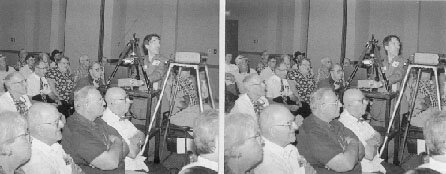 MEDIUM FORMAT MAGIC by Tom Deering revealed how inexpensively you can get into medium format (generally 120 square) stereography and covered cameras, viewers, mounting, projection, and equipment sources. Along with wide experience in stereo work, Tom has the sort of boundless energy and enthusiasm that would hold the attention of even someone without the slightest interest in the subject of his presentation.
MEDIUM FORMAT MAGIC by Tom Deering revealed how inexpensively you can get into medium format (generally 120 square) stereography and covered cameras, viewers, mounting, projection, and equipment sources. Along with wide experience in stereo work, Tom has the sort of boundless energy and enthusiasm that would hold the attention of even someone without the slightest interest in the subject of his presentation.
HOW TO PUBLISH A 3-D BOOK by Stuart Stiles invited several authors of books containing stereo images to share insights, challenges, problems and ideas associated with publishing any sort of album, magazine or book involving 3-D. The presenter is the author of "Stereoscopic Saratoga Springs" and currently working on another publication featuring historic views.
THE INS AND OUTS OF STEREO SLIDE VIEWERS by George Themelis gave members a chance to learn from the master of all viewers how to select, use, maintain and improve them. This included details of optical, mechanical and electrical systems and tips on batteries, transformers, light bulbs, cleaning contacts, replacing lenses and enlarging apertures for viewing wider format slides.
DIGITAL PHOTO MANIPULATION by Tom Deering demonstrated ways of using software to repair, enhance and totally fake photographic images. A computer and digital projector, combined with Tom's very animated presentation style, showed how these techniques can be applied to stereoviews, slides and web pages.
STEREO SLIDE MOUNTING by Jon Golden and George Themelis explained the basic principles of stereo slide mounting and reviewed the equipment and mounts available. Examples of mounting errors were demonstrated in stereo projection.
RESTITCHING A CAMERA CASE by Bill Davis showed how to remove and replace the often 50 year old, worn thread from stereo camera cases and replace it with stitching superior to but indistinguishable from the original. First presented at NSA '98 in Richmond, this very practical technique was demonstrated on a Kodak Stereo field case.
In the days following the convention, several rave reviews appeared among discussions on the internet's photo-3d group. One, from the convention's Workshops Coordinator Bill Moll provided some interesting insight:
What do Dr. T, Tom Deering and David Lee have in common- Going to one of their workshops is like going to a revival meeting! There is so much 3-D energy that it just bounces off the walls. I would like to thank George, Tom, David, Bill Davis, Stuart Stiles, Harry zur Kleinsmiecle, Russell Norton, Steve Berezin, Keiichiro Sei, John Birchak and Dwight Cummings for their contributions to the NSA workshops. Next year, we are going to have three times the number with a full track for digital and video. A good example of what comes out of these conventions is the workshop on digital 3-D cameras. I declined David Burder's offer to Fed Ex his over from England-he has Kodak and Apple versions. Steve Berezin had his, but it seemed like it was going to be a slim session. Steve took his apart to show how he synchronized them. Using a clever Velcro attachment, he was able to get three different lens spacings! However, Sei-san (from Kanagawa, Japan) arrived with not one, but two cameras. One was a twinned unit with merged controls, much like a typical Dreme and glue job. It produced good images (two 640X480 vertical) printed on a Canon inkjet printer. The second was a beam splitter made from pieces of a Fed beamsplitter and a Ricoh digital camera. The beamsplitter was very well made, looking like a factory job. It attached using the tripod connection. The screen was marked to indicate the actual image. Then, when I started to fill time discussing twinning the Minolta 1500, Dwight Cummings offered up his experience using the Dimage V. Using this earlier model, he utilized the detachable lenses to put them on a slide bar and used the camera LCD screens as a stereo view finder. After this proof-of-concept, John Birchak talked about the upgraded programming language for the Minolta 1500 (yes - it uses Digita). Combining all of our pieces, we should have a really sharp 3-D digital camera ready soon!
Awards
The annual Awards Banquet has grown so big that this year it had to be held at the Days Inn Motel, across the street from the Regency Suites where nearly every guest and meeting room was occupied by NSA members or functions. National Stereoscopic Association President Larry Moor described and handed out the awards:
THE WILLIAM C. DARRAH FELLOW AWARD for distinguished scholarship in and extraordinary knowledge of stereoscopy went to Mary Ann and Wolfgang Sell.
 THE ROBERT M. WALDSMITH AWARD for meritorious service to the NSA went to Lois Waldsmith, who was at the same time given the NSA HONORARY LIFETIME MEMBERSHIP AWARD for the many years she has handled the details of membership applications and renewals, requests for back issues of Stereo World, and the organization and operation of the NSA table at conventions.
THE ROBERT M. WALDSMITH AWARD for meritorious service to the NSA went to Lois Waldsmith, who was at the same time given the NSA HONORARY LIFETIME MEMBERSHIP AWARD for the many years she has handled the details of membership applications and renewals, requests for back issues of Stereo World, and the organization and operation of the NSA table at conventions.
THE EDWARD B. BERKOWITZ AWARD for the best article on historical stereoscopy in a recent issue of Stereo World went to Denis Pellerin and Pierre Tavlitzki for their continuing column "European Gems-Stereoviews From Old Europe and the Stories Behind Them". Honorable Mentions went to Lynn Marie Mitchell for "Daniel Hubbard Cross: Photographer and Musician, 1836-1918" in Vol. 25 No. 6 and to Bert M. Zuckerman for "Charles Bierstadt's Stereoviews of Tripoli, Egypt and Palestine" in Vol. 25 No. 4.
THE LOU SMAUS AWARD for best article on contemporary stereoscopy went to Don Marren for "Remembering Noel Archambault: 1961-1998" in Vol. 25 No. S. Honorable Mention went to Boris Sarotsa for "On Stereo Imaging of Pixies, Fairies, and Other Ephemera" in Vol. 25 No. 6,
THE PAUL WING AWARD for the best Stereo Theater projection show at the current convention went to Ernst Lips for Anamorphics From Switzerland. THE WILLIAM A DUGGAN AWARD for the best Stereo Theater show by a first time presenter went to Lawrence A. Haines for Orcas Island in Stereo. AN NSA SPECIAL COMMENDATION AWARD went to Oliver and jean Reese of the H.H. Bennett Studio Foundation for the preservation and restoration of one of the last intact sites of America's great frontier photographers, the H.H. Bennett Studio in Wisconsin Dells. (See Vol. 25 No. 1, page 29.) Besides helping fund a multi-million dollar restoration project with the State Historical Society of Wisconsin, Oliver and Jean Dyer Reese (Bennett's great-granddaughter) have donated a large selection of original Bennett views to the NSA Holmes Library.
Competitive Viewcard Exhibit
This convention saw the first presentation of the new TEX TREADWELL AWARD for the best NSA stereoview display in any category, which went to David E. Klutho for Stop and See the Action.
In the Vintage category, FIRST PLACE went to Lynn Marie Mitchell and Milton Miller for W.R. Cross Images of the Black Hills.
SECOND PLACE went to Bonnie and Ken Williams for Views of Milwaukee.
THIRD PLACE went to Bonnie and Ken Williams for Early Michigan and Wisconsin Mining.
THE PRESIDENT'S AWARD also went to Bonnie and Ken Williams for Deadwood ' Dakota Territory.
HONORABLE MENTION went to David Miller for Less Common views of the
Great Chicago Fire and for Streets of Chicago.
In the Modern category, FIRST PLACE went to David E. Klutho for Stop and See the Action, which also earned the TEX TREADWELL AWARD.
SECOND PLACE went to George Freeman for No Fishing From the Highway.
THIRD PLACE went to Stan White for 5.x 7 Stereo Cards.
HONORABLE MENTION went to Bill Walton for Time Machine and to David E. Klutho for Take Me Out to the Ball Game.
A View-Master Keynote
With the 60th anniversary of View-Master the same year as the NSA's 25th, Fisher-Price sent several people to the convention, demonstrated the new Virtual Viewer at the View-Master meeting Thursday afternoon, donated special anniversary viewers to the Spotlight Auction, and provided a speaker for the Awards Banquet.
Director of Product Design at Fisher Price Dave Ciganko opened with a toast to the dual anniversaries of View-Master and the NSA, continuing with a brief history of View-Master while acknowledging that "there are people here that know far more about the history of View-Master than I do." Illustrated with (flat) digital projection of examples, his presentation traced the evolution of View-Master reels from mainly scenic subjects through table-top scenes from children's stories and cartoons to the present concentration on popular
movie and animated TV subjects. View-Master's corporate history was covered from Sawyer's to Mattel/Fisher-Price, where it is now seen as an important part of the firm's line and a unique product for those involved with it like Mr. Ciganko:
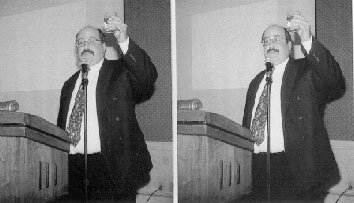 I've been at Fisher-Price in product design and development for over 20 years and I can honestly tell you that I've worked on few products that I personally feel very passionate about. I haven't been involved with View-Master for many years, but where I have, it is really passionate. That's why I'm here today-its sense of history, its role as a pop icon, its fundamental appeal to children as well as adults really make it unique among products of the 20th century.
I've been at Fisher-Price in product design and development for over 20 years and I can honestly tell you that I've worked on few products that I personally feel very passionate about. I haven't been involved with View-Master for many years, but where I have, it is really passionate. That's why I'm here today-its sense of history, its role as a pop icon, its fundamental appeal to children as well as adults really make it unique among products of the 20th century.
.... View-Master is a classic toy with 60 years of success. Few products have lasted that long. The product line enjoys 100% awareness. Most people today, if you ask them "do you know View-Master-" They'll go, "I absolutely know View-Master. Do they still make that-" Obviously, our challenge is to insure that consumers know that View-Master is still being made, is still a relevant product for today's computer age kids. Our decision in the spring of ,1997 was to essentially plan to refresh, reenergize, and relaunch the View-Master line with new packaging, progressive retail awareness, and diverse content beginning in 1998 and culminating this year with the introduction of the new Virtual Viewer.
One of the first things we did in 1997 was to recognize the value and awe inspiring challenge of organizing and cataloging what I call a Smithsonian-like collection of slides, negatives, hand painted cells and table-top models that were in storage in Portland. From the coronation of Queen Elizabeth to the Apollo 11 launch, we had thousands of priceless 3-D images that needed protection at our headquarters in East Aurora. We established, under lock and key, I might add, two temperature-control led rooms containing virtually every View-Master product and image. I wouldn't say every one, we're certainly looking for a lot of them that were lost over the years. Also stored there are some of the most spectacular original, hand-painted cells that I have ever seen.
.... Perhaps most importantly, we took a long hard look at the View-Master line and decided to make some significant changes. Our goal is to make every single product in the line better than it was before. As an example, over the past few decades, View-Master has swung very far over to the major movie and TV entertainment content. We wanted to incorporate more real-life shots to provide a more diverse offering to consumers. We also wanted to dial up the educational content. As a result, in November of 1998, the Discovery Channel Gift-set was launched, featuring a new viewer format and exciting images from an up-front, in your-face company such as Discovery... In just seven short weeks, the Discovery Channel gift set was the number one dollar-generating gift set of the year.
We're always looking to improve the production quality of our images. Beginning this year, we've enhanced reel images by using a new clearer, brighter film and adding colorful graphics to the center area of the reel which was previously undecorated. Then of course, there's the Virtual Viewer that we've talked about with its wrap-around visor and 50% larger images to literally put you inside the 3-D experience. The viewers come in various colors giving a completely fresh and contemporary appearance to our product. So far, reaction at retail has been really positive...
So what's in store for the future- Look for an unusual new viewer format in 1999 and 2000 that we call the Pocket Viewer. It's 3-D images that are integrated into this compact viewer.. This will appeal to a slightly older child, and it will also, we hope, become a more collectible viewer at a very good collectible price - and it'll probably get us into different channels of distribution and once this takes, reels will probably go along with it .... The first license that we're excited about for this line is IMAX. We all know [MAX, and its larger-than-life images are a perfect match for View-Master 3-D reels .... Of course, how would you like to have a View-Master web site- We've been asked that over and over. Although we're not nearly ready yet, we're certainly in a prod uct-development stage and we are really anxious to get started.
So I don't need to tell you that View-Master represents much more that a beloved toy from our childhood. Long before Microsoft was asking "Where do you want to go today-" we were already discovering the world in 3-D on View-Master sets. As the world's leading preschool toy maker, Fisher-Price has enthusiastically embraced the charge of revitalizing this treasured brand by improving the product, and looking for ways to bring renewed excitement to the images. The team working on View-Master now includes 18 designers, engineers, artists and marketers-it's actually one of the largest teams within the Fisher-Price design R&D staff.
Mr. Ciganko concluded by reminding the packed room that over a billion people have experienced 3-D thanks to View-Master and that Fisher-Price is committed to growing the business both nationally and internationally by using its considerable technological and human resources to constantly improve the product.
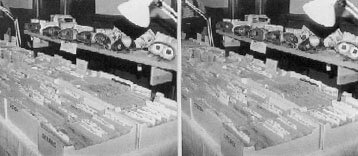 The Trade Fair
The Trade Fair
With only 89 tables available, this year's Trade Fair may have been physically smaller than many in recent years, but the packed aisles and brisk business done by dealers of both vintage and current stereo material made it one of the more successful. The only complaint heard from some dealers was that, for a modem convention facility, light levels in the Regency Conference Center (of which the NSA was using every square inch) were a bit lower than expected. Some dealers set up swing-arm lamps to make 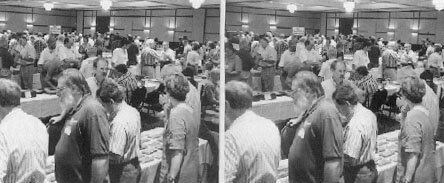 inspection of views along their tables easier. Wrapped around the room used for the Stereo Theater, the Trade Fair was in an L-shaped space with the Competitive View Cards and other exhibits set up in the leg of the L behind the Stereo Theater section. To avoid taking up scarce table space inside, Lois Waldsmith and the NSA tables were placed in the bright and spacious Conference Center lobby.
inspection of views along their tables easier. Wrapped around the room used for the Stereo Theater, the Trade Fair was in an L-shaped space with the Competitive View Cards and other exhibits set up in the leg of the L behind the Stereo Theater section. To avoid taking up scarce table space inside, Lois Waldsmith and the NSA tables were placed in the bright and spacious Conference Center lobby.
A Monday Tour Through the Door
The Regency Suites Hotel is located near the Fox River, on the north end of town not far from where the river empties into the lower end of Green Bay itself. The long, narrow peninsula that sticks into Lake Michigan and forms the eastern shore of Green Bay is Door County, site of the 1999 NSA Monday bus tour. Two buses of eager stereographers traveled up one side of the county and down the other, stopping at historic harbors, lighthouses and farming communities. The midway stop for lunch was a high point for more than reasons of pure hunger on this tour. In Ellison Bay, one of the area's ubiquitous small towns dominated by quaint bed & breakfast inns, antique shops, art galleries and boutiques, we pulled into what resembled a left-over 1950s tourist site more than any of the precisely restored or imitation historic structures around. The Viking Grill & Gift Shop is dominated by a painted Viking fisherman sign on its low roof and a carved wooden troll standing on the porch. But it was the huge steaming kettle standing over an open fire that drew the most attention.
Several times a day, local whitefish are boiled in heavily salted water for a traditional Door County fish boil. just as the fish are nearly ready, gasoline is tossed on the fire as customers gather round with cameras (in this case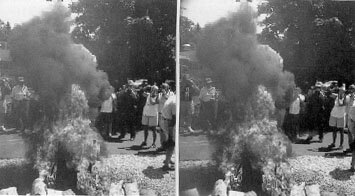 stereo) ready. The resulting fireball causes the water to boil over the sides of the kettle in a cloud of steam and smoke, taking much of the fat, oil and salt with it. Two "boilovers" were required to feed the NSA throng, which filled the mess-hall style tables inside and most of the picnic tables in front of the building.
stereo) ready. The resulting fireball causes the water to boil over the sides of the kettle in a cloud of steam and smoke, taking much of the fat, oil and salt with it. Two "boilovers" were required to feed the NSA throng, which filled the mess-hall style tables inside and most of the picnic tables in front of the building.
Surprisingly tasty but delicately flavored, the fish was a hit with nearly everybody, as was the pie made from locally grown cherries. Much of the agricultural land between the tourist towns is devoted to cherry and apple orchards. One tour stop brought us to the tip of the peninsula, providing a view of the strait separating the mainland from nearby Washington Island. The name of the county stems from the name given this waterway by both local Native American tribes and later settlers who lost numerous canoes, boats and ships in the often treacherous water-earning it the title "The Door of Death". Since that's not the most enticing name for development or business., it was shortened to Door as a county name. A ship canal at Sturgeon Bay was later cut through the center of the peninsula to allow safe passage between Lake Michigan and Green Bay, and the town of Sturgeon Bay grew into a major port for the repair and building of lake steamers.
With the terrain, the attractions and the local history laid out with such nearly linear convenience, tour guides from the Green Bay Area Visitor and Convention Bureau were able to make the tour especially interesting by filling in the background of each passing area or stop. Accustomed to tourists seeking sweeping vistas for their cameras, the guides had to explain that stopping for such stereogenic opportunities as crumbling barns was impossible on the narrow, busy roads of the county. With nobody on board who needed to catch a plane that evening, one bus did take an extra couple of hours on the return journey, making several unscheduled stops to the delight of stereographers and the distress of tour planners.
NSA Board Meeting
At the Thursday evening meeting of the NSA board of director it was decided that Stereo World bulk mailings which in the past have been sent via nonprofit bulk mail (the cheapest possible), would be changed to regular bulk permit mailings, allowing commercial inserts to again go to all NSA members. The slight cost increase was seen as worthwhile in the effort to regain some members who have failed to renew in recent years due to the absence of the insert feature for auctions, sales, etc. An insert in Vol. 26 No. 1 gave details on the renewed service.
With the retirement of Bill Moll from the position of Vice-President in charge of Activities, the board approved the selection of Dean Kamin to fill that post, which involves the selection of future convention sites and negotiating with hotels for the best facilities and rates.
The award for the best Stereo Theater show from first-time presenters was made a regular feature of banquets and named the William A Duggan Award. It was also confirmed that Lifetime Membership awards would be decided on by the board on a case-by-case basis, and that while names of some particular individuals deserving this special recognition had been mentioned, the award would not necessarily be made every year.
Thanks to:
Special thanks go to all who made NSA Green Bay '99 such a success, from on-the-spot volunteers to attendees, dealers, presenters, exhibitors and contestants as well as the following:
Harry Richards-Convention Chairman '99
Bob Swenson-Registrar & Treasurer
Dean & Carol Kamin-Trade Fair Coordinators
John & Dace Roll-Stereo Theater Coordinators
Bill Moll-Workshops Coordinator
Bruce Springsteen-Exhibits Coordinator
Dave Wheeler-Auction Coordinator
Tim & Karen White-Program Book Coordinators
Dan Shelly-Convention Website
Wolfgang & Mary Ann Sell-Screen Transportation
Bill Duggan-NSA Projection Consultant
Mark Moriarity-Convention Logo design
Ernst Lips-Green Bay Postcard Design
Next Year
NSA in Y2K, Mesa, Arizona, will take place July 6 - 10, Thursday through Monday, at the Sheraton Mesa, or . The special convention room rate is $68.00 a day. Make your reservation soon, as the hotel has only 273 rooms, with 220 reserved for the NSA.
For more photos of NSA '99 see http://www.dddesign.com/3dbydan/nsa99/ and check the same site for eventual details on NSA 2000.
